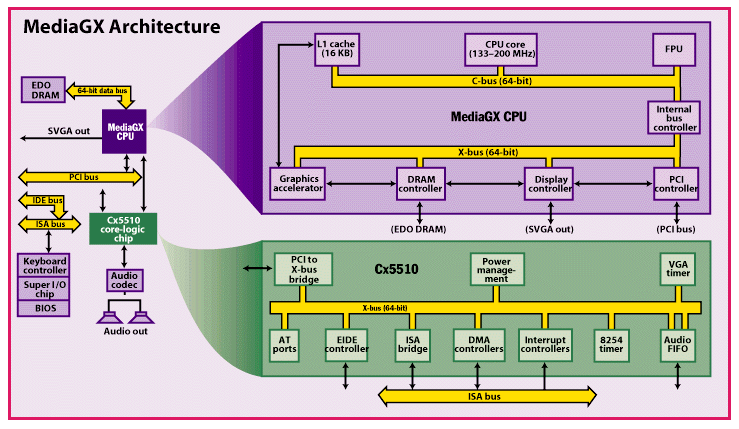| The key to inexpensive Windows PCs is higher
integration, and Cyrix is leading the way. Its MediaGX
processor delivers Pentium-class integer performance while
integrating the functions of an SVGA graphics card, a DRAM
controller, a PCI controller, and other parts of the
system core logic. A companion chip, the Cx5510, emulates
a 16-bit Sound Blaster while bridging to the ISA bus, a
two-channel IDE bus, and other system devices (see the
figure "MediaGX Architecture"). When paired together, these chips enable very-low-cost PCs. For one thing, the system doesn't need a dedicated frame buffer, because the MediaGX uses about 2 MB of main memory for graphics. Usually, a unified memory architecture degrades performance by 10 percent to 15 percent. But because the MediaGX integrates the graphics controller with the CPU, graphics data doesn't flow over a 32-bit, 33-MHz PCI bus. Instead, the data travels between the CPU and the graphics controller over a 64-bit internal bus clocked at the core frequency. The chip also compresses the graphics data on the fly to reduce bus traffic. Similarly, the MediaGX does without a Level 2 (L2) cache. The integrated memory controller communicates with the CPU core over the internal bus, slashing the time required for memory accesses. Although the chip might run a little faster with a cache, the difference isn't great enough to justify the extra cost in a low-end system. The MediaGX does have a unified 16-KB Level 1 (L1) cache, and it supports extended data out (EDO) RAM expansion to 128 MB. When Cyrix began shipping the MediaGX in late 1996, the core speed was 133 MHz. Since then, Cyrix has introduced versions that run at 150 and 166 MHz, with a 200-MHz chip due soon. These cores don't support MMX and have relatively poor floating-point performance, but they can match or beat the Pentium when running common integer-intensive applications. In the second half of this year, Cyrix plans to introduce a next-generation integrated chip known as the MXi. It's built around Cyrix's Cayenne core, which has a 64-KB L1 cache, a superscalar FPU, MMX support, improved integer units, and 15 new instructions for speeding up 3-D graphics (see "Beyond MMX," December 1997 BYTE). The MXi will also integrate the Accelerated Graphics Port (AGP), digital versatile disc (DVD) playback, and a synchronous DRAM (SDRAM) controller. Cyrix claims that the MXi will match the performance of Pentium II processors running at 300 to 400 MHz, and that the integrated 3-D graphics controller will render more than 2 million pixels per second. National Semiconductor's recent acquisition of Cyrix opens the door to even higher levels of integration in the future. National is a leading supplier of the Super I/O chips that control keyboards, mice, I/O ports, and other motherboard interfaces. As far as is known, no other vendor of x86 chips is pursuing such high levels of integration with the latest CPU cores.  Cyrix's MediaGX consists of two highly
integrated chips:
the MediaGX CPU and the Cx5510. Copyright 1994-1998 BYTE |